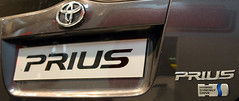It's benefits enrollment season. This year I'll be investigating Health Savings Accounts(HSAs) to see if they make sense for me. I learned some useful things from the following two articles. First, a personal account of using an HSA from a University of Minnesota professor:
In the name of academic research, finance professor Stephen T. Parente got his physician wife to agree, reluctantly, to make a radical change in their family's medical coverage. The health-economics specialist who teaches at the University of Minnesota's Carlson School of Management had realized he knew a lot about health savings accounts (HSAs) as a scholar. But he had no experience with them as a consumer. So two years ago he enrolled himself and his family in a high-deductible insurance plan linked to a tax-sheltered HSA for medical expenses.
[...]
So what has he learned as a consumer? Just as with his previous insurance, he doesn't worry that medical bills will cause financial ruin. Once he exhausts his $5,000 deductible, his insurance kicks in and his family is protected against disaster. In addition, he is now fully covered for preventive care to encourage sound medical habits, a relief with three children, ages 2, 5, and 10. Such services includes immunizations and well-child care, as well as annual physicals and mammograms. Some 82% of high-deductible/HSA plans follow this practice, according to the Kaiser survey.
Parente has been surprised by the cost of using an HSA. The premium of $84.20 per biweekly pay period is only about 12% less than a preferred provider plan, and he thinks the savings should be greater. Parente also puts $3,650 in the HSA to reach the maximum contribution (the university puts in $2,000), but the money belongs to him, not an insurance company.
[...]
The savings should be much greater. Why would I assume the increased risk and increased deductible for such a paltry savings? Continuing on:
Parente says there still isn't enough data to confirm whether the combination of consumer-driven insurance and HSAs lives up to its promise. A lot of the talk in health policy circles about savvy consumers shopping for the best deal is hype. The only good price information currently involves pharmaceuticals. Consumers can go online and compare prices of brand-name drugs vs. generic competitors, or mail order vs. local pharmacy, and so on. "But the notion that it's possible to shop for physician prices, that there's a marketplace in doctors, well, it just isn't there," he says.
[...]
This article is failing to convince me to go with the HSA/high deductible health insurance plan. Then there is
this WSJ article on HSAs (
free WSJ Digg link):
[...]
The numbers of U.S. workers enrolled in such plans through their jobs (excluding dependents and those in firms with fewer than three workers) grew only slightly, to 2.7 million in 2006 from 2.4 million in 2005, according to the Kaiser Family Foundation. Most do it because either their companies give them no choice or the premiums are the cheapest. Enrollment is growing faster on the individual market and among sole proprietors, but that may be because the plans are often the only affordable option.
Where employees do have a choice, only 19% choose the newfangled plans, the Kaiser study estimates. In the Federal Employees Health Benefits Program,
which has offered the plans for several years, only about 50,000 of its eight million members were enrolled in them in 2006, according to industry estimates. At lightbulb-maker Osram Sylvania, just 5% of employees enrolled in the plans in
2006, their first year.
In addition, those who are in consumer-directed health plans often report lower satisfaction and confusion about how the plans are supposed to work. The general idea is for patients to conserve money in their savings accounts, which are meant to pay for care until they reach their high insurance deductible. In theory, patients who shop carefully could have money left over, which they can keep and let build into savings for bigger health-care costs down the line.
[...]
One reason for the frustration is the uphill battle many consumers describe in trying to shop for their health care. Six years ago, Howard Katz, an industrial-design research consultant in rural eastern Pennsylvania, bought a family health plan with a savings account and a deductible that is now $5,650. But getting specific price information on which to base purchase decisions for MRIs, doctor visits and blood work has been difficult, he says.
[...]
This article doesn't give me the warm and fuzzies about HSAs either. Still, I'll be doing a careful analysis of my own HSA option soon to see if it's viable.



